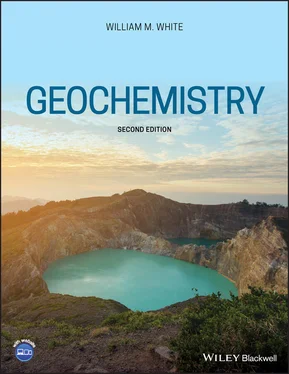12 The dissociation constant for hydrofluoric acid (HF) is 10−3.2 at 25°C. What would be the pH of a 0.1 M solution of HF? You may assume ideal behavior. (Hint: Ask yourself what addition constraints are imposed on the system. Your final answer will require solving a quadratic equation.)
13 The first dissociation constant for H2S is K1 = 9.1 × 10−3. Neglecting the second dissociation and assuming ideality (i.e., activity equals concentration), what is the pH of 1 liter of pure water if you dissolve 0.01 moles of H2S in it? What fraction of H2S has dissociated?(HINT: Assume that the concentration of OH− is negligible (in other words, no autodissociation of water) and use the quadratic equation for your final solution.)
14 Given the following analysis of biotite and assuming a mixing-on-site model for all sites, calculate the activities of the following components:SiteIonIons per siteTetrahedralSi2.773Al1.227OctahedralAl0.414Ti0.136Fe3+0.085Fe2+1.399Mg0.850InterlayerCa0.013Na0.063K0.894AnionOH1.687F0.037Hint: Check your result by making sure the activity of phlogopite in pure phlogopite is 1.
15 Given the following analysis of a pyroxene, use the mixing-on-site model of ideal activities to calculate the activity of jadeite (NaAlSi2O6) and diopside (CaMgSi2O6) in this mineral:SiteIonIons per siteTetrahedralSi1.96Al0.04Octahedral M1Al0.12Mg0.88Octahedral M2Fe2+0.06Ca0.82Na0.12
16 Write the equilibrium constant expression for the reaction:assuming the solids are pure crystalline phases and that the gas is ideal.
17 Assuming ideal solution behavior for the following:Show that the boiling point of a substance is increased when another substance is dissolved in it, assuming the concentration of the solute in the vapor is small.By how much will the boiling point of water be elevated when 10% salt is dissolved in it?
18 Find for the reaction:Which side of the reaction is favored?(Hint: Use the data in Table 3.3.)
19 What is the for the reaction:What is the pε° for this reaction?
20 Consider a stream with a pH of 6.7 and a total dissolved Fe concentration of 1 mg/l. Assume ideal behavior for this problem.If the stream water is in equilibrium with the atmospheric O2 (partial pressure of 0.2 MPa), what is the pε of the water?Assuming they are the only species of Fe in the water, what are the concentrations of Fe3+ and Fe2+? Use the pε you determined in part a.
21 Write reactions for the oxidation of nitrogen gas to aqueous nitrite and nitrate ions that contain the electron and hydrogen ion (i.e., reactions suitable for a pε–pH diagram). Write the log equilibrium constant expression for these reactions. Using the data below, calculate the log equilibrium constant for these reactions under standard state conditions). Calculate pε° and for these reactions.SpeciesH2O−237.19N2 (gas)0−111.3−32.2Standard state is 25°C and 0.1 MPa. R = 8.314 J/mol-K.Hint: remember, in the standard state, all reactants and products have activities of 1.
22 Construct a pε–pH diagram for the following species of sulfur: , , H2S, HS–, and S2– at 25°C and 0.1 MPa. The following free energies of formation should provide sufficient information to complete this task.SpeciesSpeciesS2− (aq)+85.81H2O−237.19HS− (aq)+12.09H+0H2S (aq)−27.82H2 (g)0 (aq)−744.54O2 (g)0HSO4– (aq)−755.92Values are in kJ/mol, standard state is 25°C and 0.1 MPa. R = 8.314 J/mol-K.
23 Construct a pε–pH diagram for dissolved species of uranium, and , and the two solid phases UO2 and U3O8 at 25°C and 0.1 MPa. Assume the activity of dissolved uranium is fixed at 10−6. The following free energies of formation should provide sufficient information to complete this task.Species (aq)−1630.80 (aq)−952.53UO2 (s)−1031.86U3O8 (s)−3369.58H2O−237.19Values are in kJ/mol, standard state is 25°C and 0.1 MPa. R = 8.314 J/mol-K.
1 *The naturally occurring minerals of varying composition are referred to as plagioclase rather than anorthite, olivine rather than forsterite, clinopyroxene rather than diopside, and orthopyroxene rather than enstatite.
2 †Caution: some books use the term number of components as synonymous with minimum number of components.
3 ‡J. Williard Gibbs (1839–1903) is viewed by many as the father of thermodynamics. He received the first doctorate in engineering granted in the US, from Yale in 1858. He was Professor of Mathematical Physics at Yale from 1871 until his death. He also helped to found statistical mechanics. The importance of his work was not widely recognized by his American colleagues, though it was in Europe, until well after his death.
4 §Francois Marie Raoult (1830–1901), French chemist, chaired the Chemistry Department at the Université de Grenoble from 1867 until his death.
5 *Named for English chemist William Henry (1775–1836), who formulated it.
6 *Antoine Lavoisier (1743–1794) laid the foundations of modern chemistry in his book, Traité de Elémentaire de Chemie, published in 1789. He died at the guillotine during the French Revolution.
7 †The term ion pair is a bit of a misnomer because such associations can involve more than two ions. In concentrated solutions, ion pairs may consist of a cation plus several anions.
8 ‡A useful mnemonic to remember this is LEO the lion says GRR! (Loss Equals Oxidation, Gain Refers to Reduction.) Silly, perhaps, but effective. Try it!
9 §Ionization reactions, where free electrons are formed, do occur in nature at very high temperatures. They occur, for example, in stars or other very energetic environments in the universe.
10 †Named for Walther Nernst (1864–1941). Nernst was born in Briesau, Prussia (now in Poland), and completed a PhD at the University of Würzburg in 1887. Nernst made many contributions to thermodynamics and kinetics, including an early version of the third law. He was awarded the Nobel Prize in 1920.
Конец ознакомительного фрагмента.
Текст предоставлен ООО «ЛитРес».
Прочитайте эту книгу целиком, на ЛитРес.
Безопасно оплатить книгу можно банковской картой Visa, MasterCard, Maestro, со счета мобильного телефона, с платежного терминала, в салоне МТС или Связной, через PayPal, WebMoney, Яндекс.Деньги, QIWI Кошелек, бонусными картами или другим удобным Вам способом.












